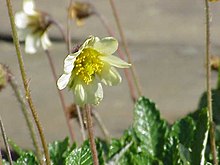Dryadoideae: Difference between revisions
Appearance
Content deleted Content added
ShortDescBot (talk | contribs) ShortDescBot adding short description "Subfamily of flowering plants" |
ce to lede |
||
| Line 12: | Line 12: | ||
* ''[[Purshia]]'' [[Augustin Pyramus de Candolle|DC.]] ex [[Jean Louis Marie Poiret|Poir.]] (including ''Cowania'') |
* ''[[Purshia]]'' [[Augustin Pyramus de Candolle|DC.]] ex [[Jean Louis Marie Poiret|Poir.]] (including ''Cowania'') |
||
}} |
}} |
||
The '''Dryadoideae''' |
The subfamily '''Dryadoideae''' consists of four genera in the family [[Rosaceae]],<ref name=Potter>{{cite journal | vauthors = Potter D, Eriksson T, Evans RC, Oh S, ((Smedmark JEE)), Morgan DR, Kerr M, Robertson KR, Arsenault M, Dickinson TA, Campbell CS | year = 2007 | title = Phylogeny and classification of Rosaceae | journal = Plant Systematics and Evolution | volume = 266 | issue = 1–2 | pages = 5–43 | doi = 10.1007/s00606-007-0539-9}}.</ref> all of which contain representative species with [[root nodule]]s that host the [[nitrogen fixation|nitrogen-fixing]] [[bacterium]] ''[[Frankia]]''.<ref>{{cite journal | vauthors = Swensen SM, Mullin BC | year = 1997 | title = The impact of molecular systematics on hypotheses for the evolution of root nodule symbioses and implications for expanding symbioses to new host plant genera | journal = Plant and Soil | volume = 194 | issue = 1/2 | pages = 185–192 | doi = 10.1023/A:1004240004063 | jstor = 42948119}}.</ref> They are subshrubs, shrubs, or small trees with a [[chromosome#Number of chromosomes in various organisms|base chromosome number]] of 9, whose fruits are either an [[achene]] or an [[compound fruit|aggregate]] of achenes.<ref name=Potter/> |
||
==Taxonomic history== |
==Taxonomic history== |
||
Revision as of 20:14, 21 March 2022
| Dryadoideae | |
|---|---|

| |
| Dryas × suendermannii | |
| Scientific classification | |
| Kingdom: | Plantae |
| Clade: | Tracheophytes |
| Clade: | Angiosperms |
| Clade: | Eudicots |
| Clade: | Rosids |
| Order: | Rosales |
| Family: | Rosaceae |
| Subfamily: | Dryadoideae (Lam. & DC.) Sweet |
| Genera | |
| |
The subfamily Dryadoideae consists of four genera in the family Rosaceae,[1] all of which contain representative species with root nodules that host the nitrogen-fixing bacterium Frankia.[2] They are subshrubs, shrubs, or small trees with a base chromosome number of 9, whose fruits are either an achene or an aggregate of achenes.[1]
Taxonomic history
The subfamily has at various times been separated as its own family (Dryadaceae), or as a tribe (Dryadeae) or subtribe (Dryadinae).[3]
References
- ^ a b Potter D, Eriksson T, Evans RC, Oh S, Smedmark JEE, Morgan DR, Kerr M, Robertson KR, Arsenault M, Dickinson TA, Campbell CS (2007). "Phylogeny and classification of Rosaceae". Plant Systematics and Evolution. 266 (1–2): 5–43. doi:10.1007/s00606-007-0539-9..
- ^ Swensen SM, Mullin BC (1997). "The impact of molecular systematics on hypotheses for the evolution of root nodule symbioses and implications for expanding symbioses to new host plant genera". Plant and Soil. 194 (1/2): 185–192. doi:10.1023/A:1004240004063. JSTOR 42948119..
- ^ J. L. Reveal. "Indices Nominum Supragenericorum Plantarum Vascularium – RA-RZ".
External links
 Media related to Dryadoideae at Wikimedia Commons
Media related to Dryadoideae at Wikimedia Commons Data related to Dryadoideae at Wikispecies
Data related to Dryadoideae at Wikispecies
